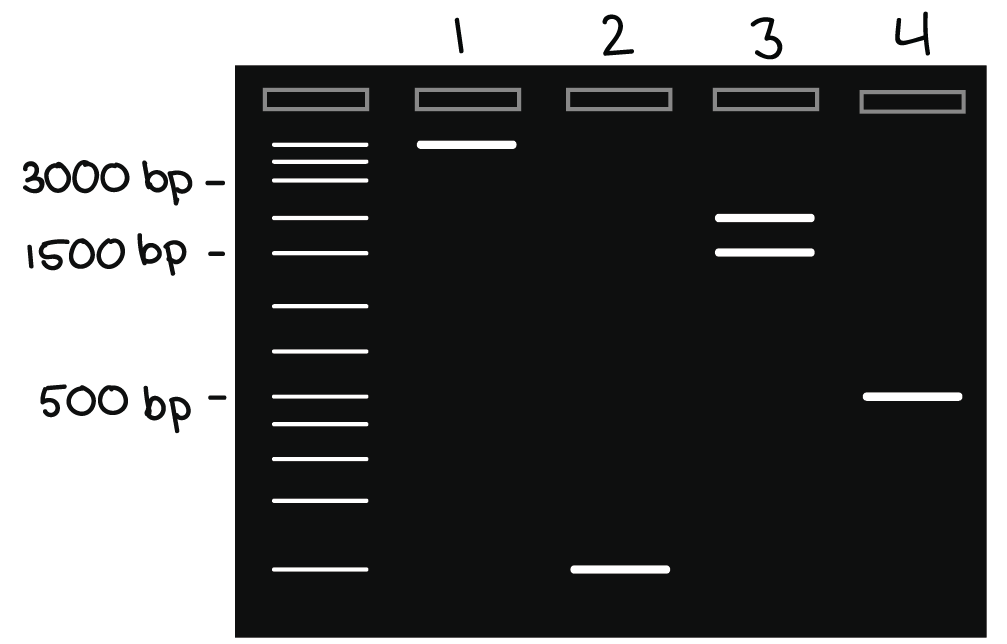Biology Module 5
1/68
Earn XP
Description and Tags
Heredity
Name | Mastery | Learn | Test | Matching | Spaced |
|---|
No study sessions yet.
69 Terms
Internal Fertilisation:
Land mammals. Increases the union of gametes and birth rate through contained environments and selective mates. Favourable traits. Time spent attaining the 'perfect' mate, increased energy used.
External Fertilisation
Release of sex cells into surrounding environment, fish and amphibians. Large number of offspring, increased genetic variation and easier fertilisation.. Fusion of gametes may not occur due to decreased chance of fertilisation and survival.
Sexual Reproduction in Animals
Gametes produced by parent organisms in meiosis, contains half necessary chromosomes. Male gamete (sperm) fertilises female gamete (ovum) -> internal or external fertilisation = zygote. Contains combination of genetical materials from parents, increases genetic variation and organism survival. Slower and less prolific than asexual reproduction.
Sexual Reproduction in Plant
Assisted by pollination -> carries male gametes to ovum. Pollen is dispersed and falls onto flower stigma (male) -> grows tube down to ovaries, fusing male and female gametes in fertilisation = new seed. Genetic diversity = higher disease resistance and adaptation, less favourable traits, more energy.
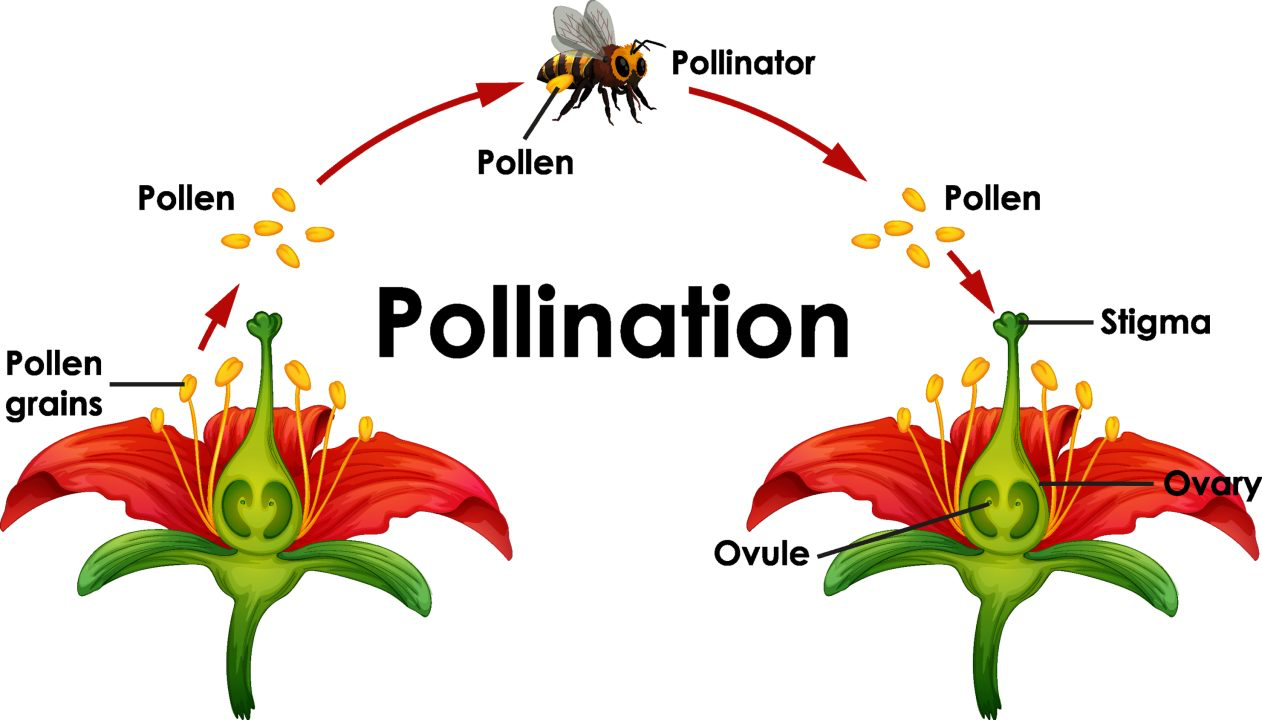
Asexual Reproduction in Plants
Structural modifications to the stem or roots = production of new individuals without seeds. Vegetative propagation. No genetic diversity = identical offspring clones, favourable traits, less energy, prone to disease.
Sexual Reproduction in Fungi
Plasmogamy: two genetically different cells fuse together
Karyogamy: nuclei fuse
Meiosis: gametes are generated which produce spores that are distributed into environment
Asexual Reproduction in Fungi
Fragmentation: pieces of hyphae can separate and become new colonies
Budding: nucleus divides and a bulge gorms in the side of the cell, then split off by cytokinesis and bud detaches itself from mother cell
Spores: meiosis produces genetically identical cells to parent, distributed into environment by wind or vectors
Asexual Reproduction in Bacteria
Binary fission. Single cell divides into two identical daughter cells. Begins with DNA replication -> genetic info. Is copied and divided into two. No genetic diversity = lower organism survival -> can be overcome with high mutation rates.
Sexual Reproduction in Protists
Haploid protists -> Genetic material is combined into new nucleus.
Diploid protists -> adult cells undergo meiosis produce four gametes. Greater variation in species due to recombinant mixing
Asexual Reproduction in Protists
Binary fission and Budding -> new organisms grow from the body of parent = new colony.
Female Hormone Production

Human chorionic gonadotropin (hCG)
Produced by tissue in early embryo -> placenta. Produced for 10 weeks before dropping off. Thickens lining of uterus to hold growing embryo. Triggers estrogen and progesterone release -> cease menstruation.
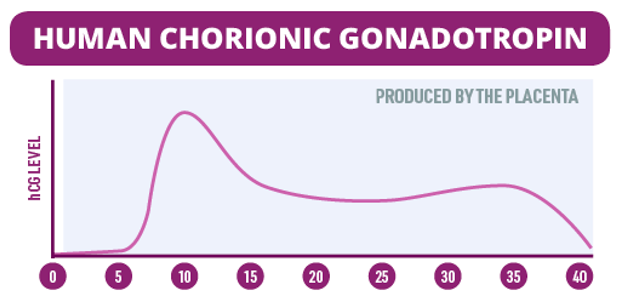
Progesterone
Produced across gestation period in corpus luteum after ovulation -> placenta. Strengthens uterine lining -> encourage glands in endometrium -> nutrients for embryo. Prepares for breastfeeding and prevents early labour.
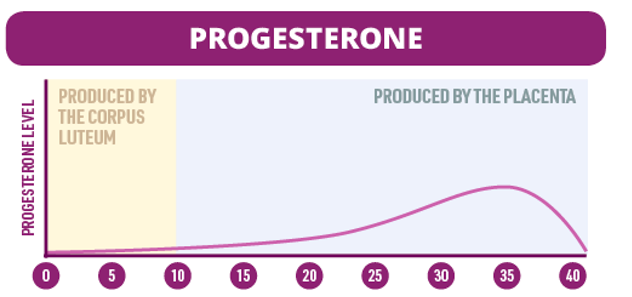
Oestrogen
Grows and thickens uterine lining in early stages of pregnancy. Assists growth of fetal organs and breastfeeding.
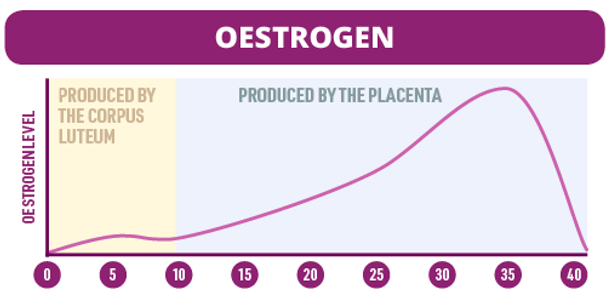
Oxytocin
Produced by the pituitary gland. Stimulates uterine contractions during labour and helps milk ejection during breastfeeding. Helps the uterus contract after birth to prevent bleeding. Peaks during labour with a spike at birth.
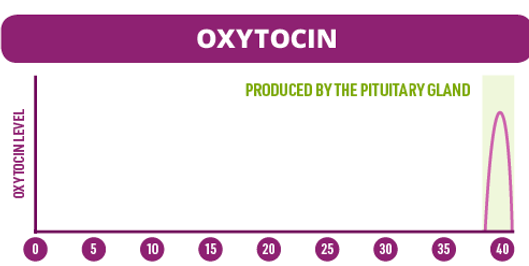
Artificial insemination
Effective timing of synchronised births, passing of favourable traits, ensuring successful pregnancy increases yields.
Detection of female cows or other animals during oestrus ('in heat')
Collection of semen, manually or by stimulation
Perform insemination using insemination gun, shoots semen into the cervix of the desired animals
Artificial pollination
Cross-breeding of favourable traits, self-pollination or creation of genetically similar offspring and ensures successful pollination of all plants, resulting in high crop yields.
Pollen (sperm) removed from the stamen of one plant
Pollen applied to the stigma of another plant
Pollen fertilises the ovum
Genetic engineering
Knowledge of DNA structure and improvement of genetic techniques has allowed the introduction of new desired traits into organisms (such as GM crops)
Bt Cotton, insect resistance
Golden rice, increased nutritional value
Strawberries, frost resistance
Nucleus genome
Cell structure with chromosomes that contain RNA and RNA -> control and regulate cell activities
Chromosomes
Exist in pairs and fixed number in different species. 46 diploid chromosomes or 23 haploid pairs exist in humans -> homologous chromosomes. Contains DNA and RNA.

Nucleic acid
Acid present in the nucleus and chromosomes -> store and express genomic information (RNA and DNA)
Eukaryotes
DNA kept in membrane-bound nucleus in cell. DNA molecules arranged into several separate chromosomes, larger and complex. Large portion of non-coding DNA. Linear -> double helix. Mitochondria and chloroplasts contain own DNA -> non-linear DNA.
Prokaryote
'primitive' -> simpler structure. Not helix shape, two circles of single-stranded DNA twisted around each other. No membrane, floats around cytoplasm. Plasmids genes -> code for features not necessarily essential for cell survival -> bacteria with selective advantage. Plasmids replicate independently of chromosomes.
DNA
Stores genetic info that controls cell and whole organism -> transmits inherited information from one cell/generation to another via cell division and reproduction. Nucleus and double stranded. Thymine not Uracil.
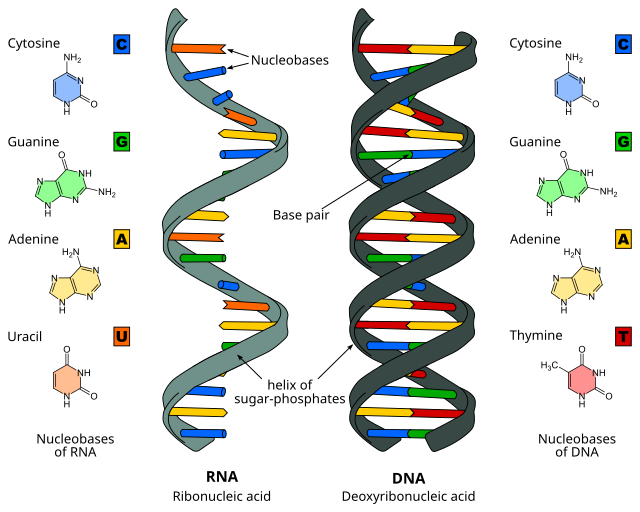
Nucleotides
building blocks of DNA -> phosphate group bound to deoxyribose sugar and nitrogen bases -> Adenine, Thymine, Guanine or Cytosine. Bases are bonded as C-G or A-T. The directional strands of DNA run antiparallel to each other from 3' to 5' and 5' to 3'.
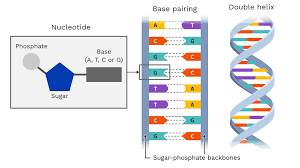
Mitosis
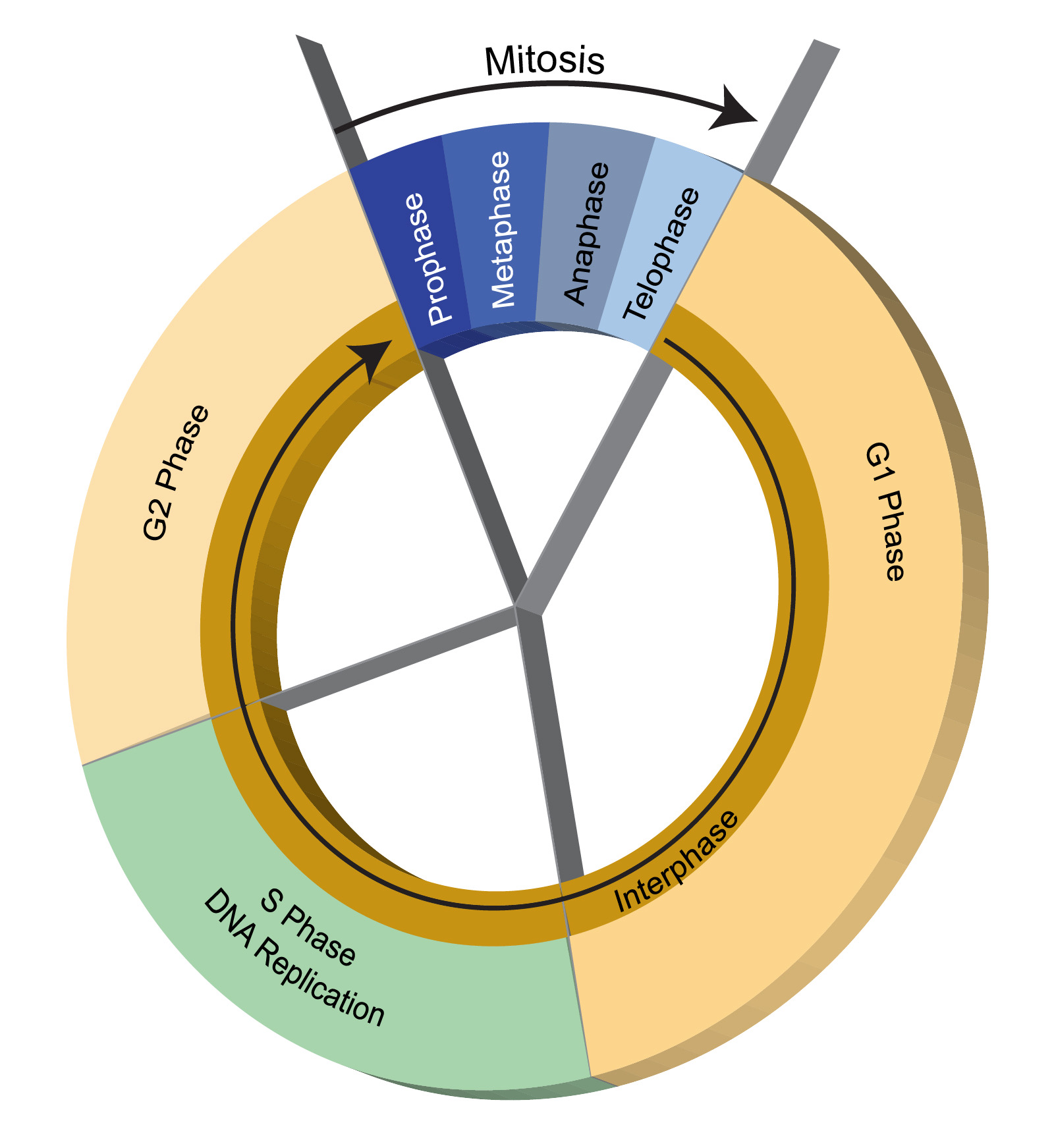
Interphase
Occurs throughout, preparing for division.
G1 (Growth) phase
Cell grows larger and increases in volume -> replicate cell organelles and develop molecular blocks for later phases.
S (Synthesis) phase
Cell replicates DNA in nucleus, doubling chromosomes -> 46 chromosomes becoming two lots of 46 to prevent mutations. (DNA replication_
DNA Replication - Anabolic reaction
Initiation: Enzyme helicase -> unwinds and separates DNA strands by breaking hydrogen bonds in bases -> replication fork for each strand
Elongation: RNA + primers bind to ends of strands -> starting point of replication. DNA polymerase binds to separated DNA strands at primer starting sites -> adds new pairs along complementary strand. A binds to T vice versa.
Leading strand -> polymerase moves from 5' to 3', with nucleotides added continuously in a long chain.
Lagging strand -> polymerase moves from 3' to 5', with primer being placed in Okazaki fragments. Discontinuous and will be fixed later on.
3. Termination: DNA polymerase backtracks and edits strand, correcting any base pair errors. = two identical daughter strands produced. The strands recoil into a double helix shape = two new DNA molecules. Ligase is used to 'proofread' the strands
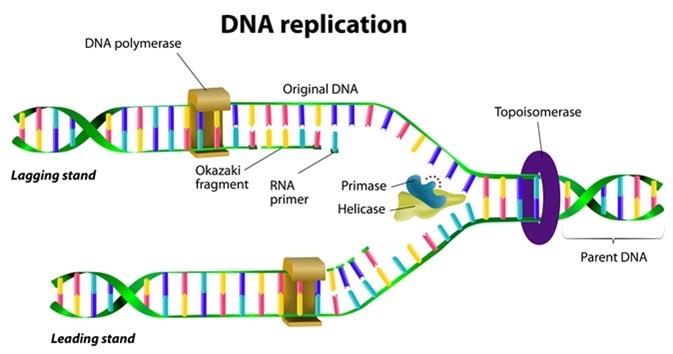
G2 (Growth) phase
Cells develop and grow = proteins and organelles in preparation for mitosis. Chromosomes are long, diffuse structures before being condensed.
Mitosis Phase
Prophase: Duplicated chromosomes condense -> mitotic spindle forms at ends of dividing cell -> lengthen and shorten to pull chromatids apart.
Metaphase: Spindles capture chromosomes and line them up at the middle of the cell, ready to divide as nucleus disassembles. Microtubules bind to the chromosome's kinetochore -> patch of protein found on centre of each sister chromatid.
Anaphase: Sister chromatids are separated and pulled to opposite ends of cell through mitotic spindles. Microtubules not attached elongate and push apart -> separate poles and make cell longer
Telophase: Chromosomes pulled to opposite ends as new nuclei form = two new cells via cytokinesis.
RNA
Found in nucleus and cytoplasm, single stranded and has uracil
rRNA (ribosomal): associated with ribosome proteins, brings mRNA and tRNA together in translation
mRNA (messenger): carries information from DNA, transporting copy from the nucleus to the cytoplasm
tRNA (transfer): assists in 'translating' mRNA message into proteins
Protein
Amino acids that assist gene expression, enzymes and cell signalling. Amino acids become proteins through polypeptide/peptide chains and bonds.
Primary: Basic sequence of amino acids that make up a protein.
Secondary: Basic folding of polymer between primary amino acids. Two structures are formed, a-helices and B-sheets. Creates structural proteins such as bone or muscle.
Tertiary: Protein folds in 3-dimensional ways into a specific sequence that determines the role of the initial protein chain. Enables the formulation of various functions such as hormones (chemical messengers) and enzymes (catalyse chemical reactions).
Quaternary: Occurs when more than one protein comes together tom make a bigger protein.
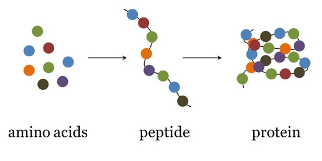
Triplet Code
Sequence of three nucleotides in DNA or messenger RNA (mRNA) -> codes for a specific amino acid. One or more triplet codes = Gene. Not all DNA sequences code for a protein. Regulatory = deciding when and where genes must produce a protein. Or no other function than to provide genetic variation.
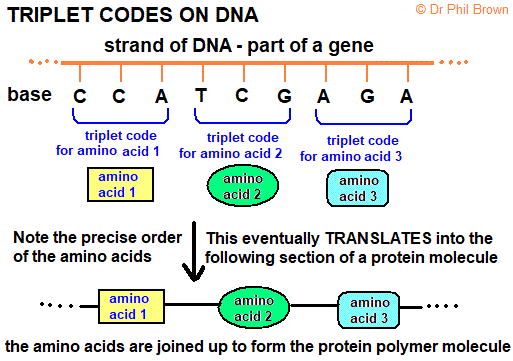
Exon
Expressing genes of DNA or RNA. In mRNA -> blueprints for amino acids to make proteins.
Introns
Noncoding gene sections of RNA that are spliced out before the RNA molecule is translated into a protein.
Polypeptide Protein Synthesis
Process to produce proteins in cells. Increases complexity of organisms. 'Variation' -> crucial for development and adaptation of species

Transcription
RNA polymerase binds to 'promoter', signals DNA to unwind -> enzyme reads bases
mRNA molecule is built, using and matching complimentary bases
mRNA detaches from the DNA strand -> splicing occurs increases variability used to express gene
Translation
Initiation: mRNA attaches to ribosome at start codon AUG
Elongation: ribosome matches the codon and anti-codons together. Polypeptide bond is formed -> continues to grow as amino acids are added
Termination: Once stop sequence is reached, chain detaches and then folds = protein
Start and Stop Codons
AUG marks the beginning of a protein
UAA, UAG and UGA signal the end of protein synthesis.
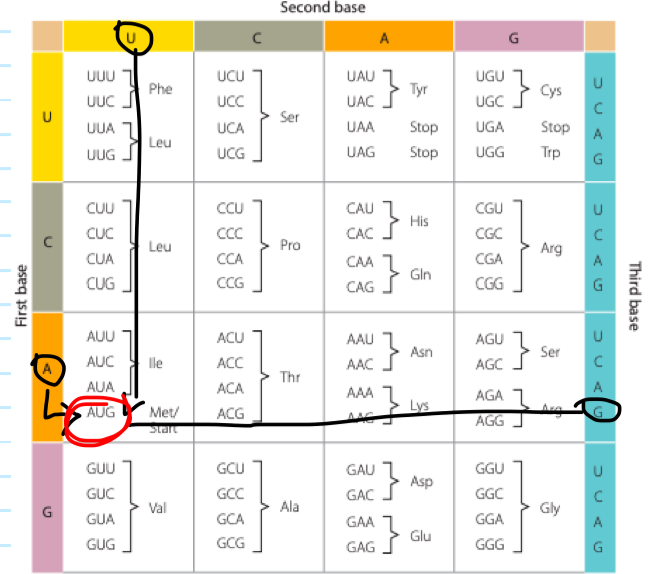
Meiosis
Cell division via sexual reproduction -> four daughter cells with half chromosomes of parents
Meiosis 1
Interphase: DNA replication occurs -> two copies of chromosomes
Prophase 1: Chromosome form X shaped structures = two chromatids genetically identical. Exchange bits of DNA/recombination. Nucleus membrane dissolves.
Metaphase 1: chromosome pairs line up in centre by meiotic spindle.
Anaphase 1: Chromosome pairs are pulled apart to either pole of cell. Sister chromatids stay together.
Telophase 1: Poles have chromosome sets -> membrane forms around sets = two new nuclei are formed. Cytokinesis separates cells = two new cells.
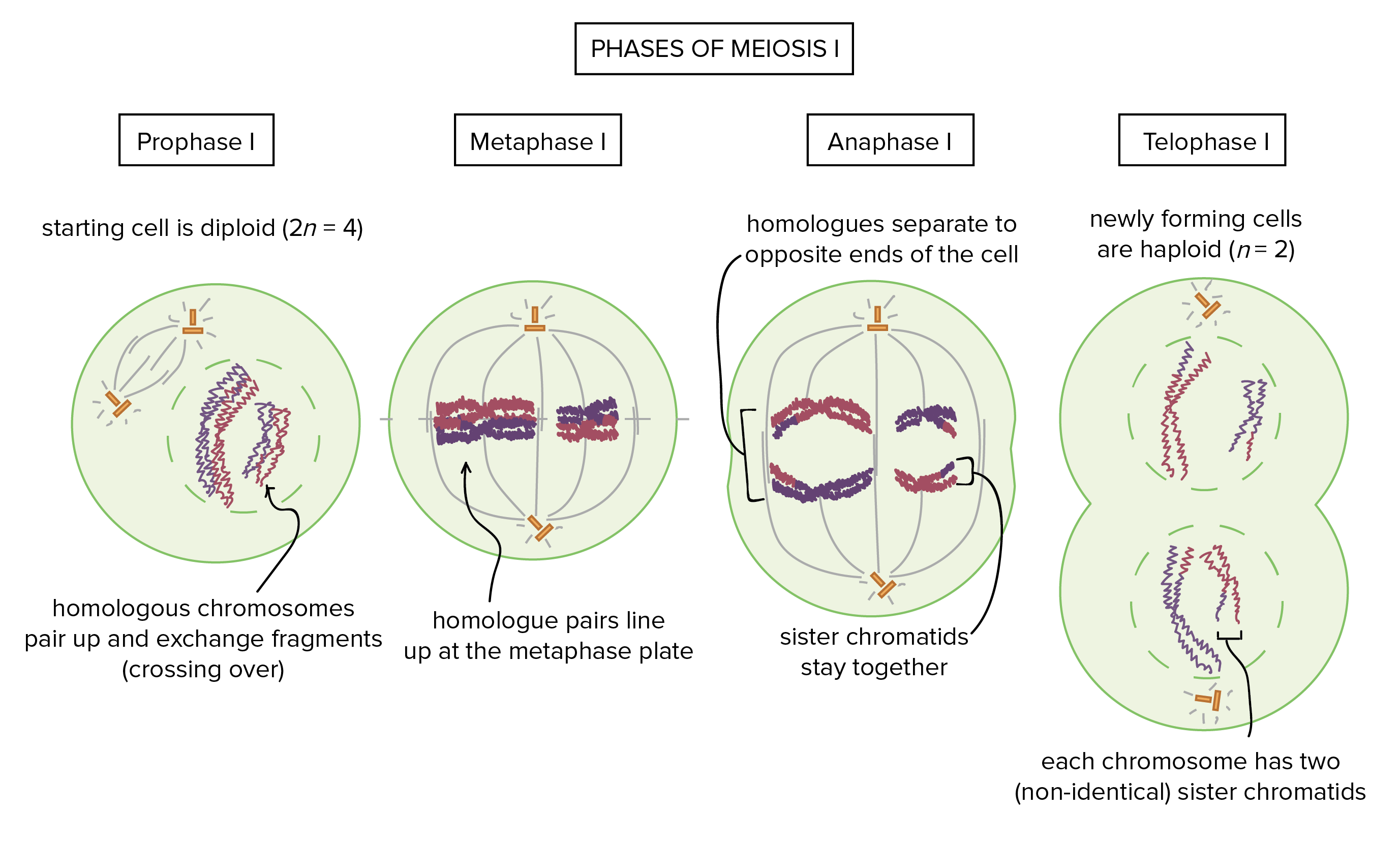
Meiosis 2
Prophase 2: Nucleus membrane around two new daughter cells dissolve. Centrioles duplicate and meiotic spindles form.
Metaphase 2: Chromosomes line up at equator. Meiotic spindles attach to each chromatid.
Anaphase 2: Sister chromatids are separated by the spindle microtubules = individual chromosomes
Telophase 2: chromosomes opposite end of cell -> membranes form = new nuclei formed. Cytokinesis occurs -> four new cells
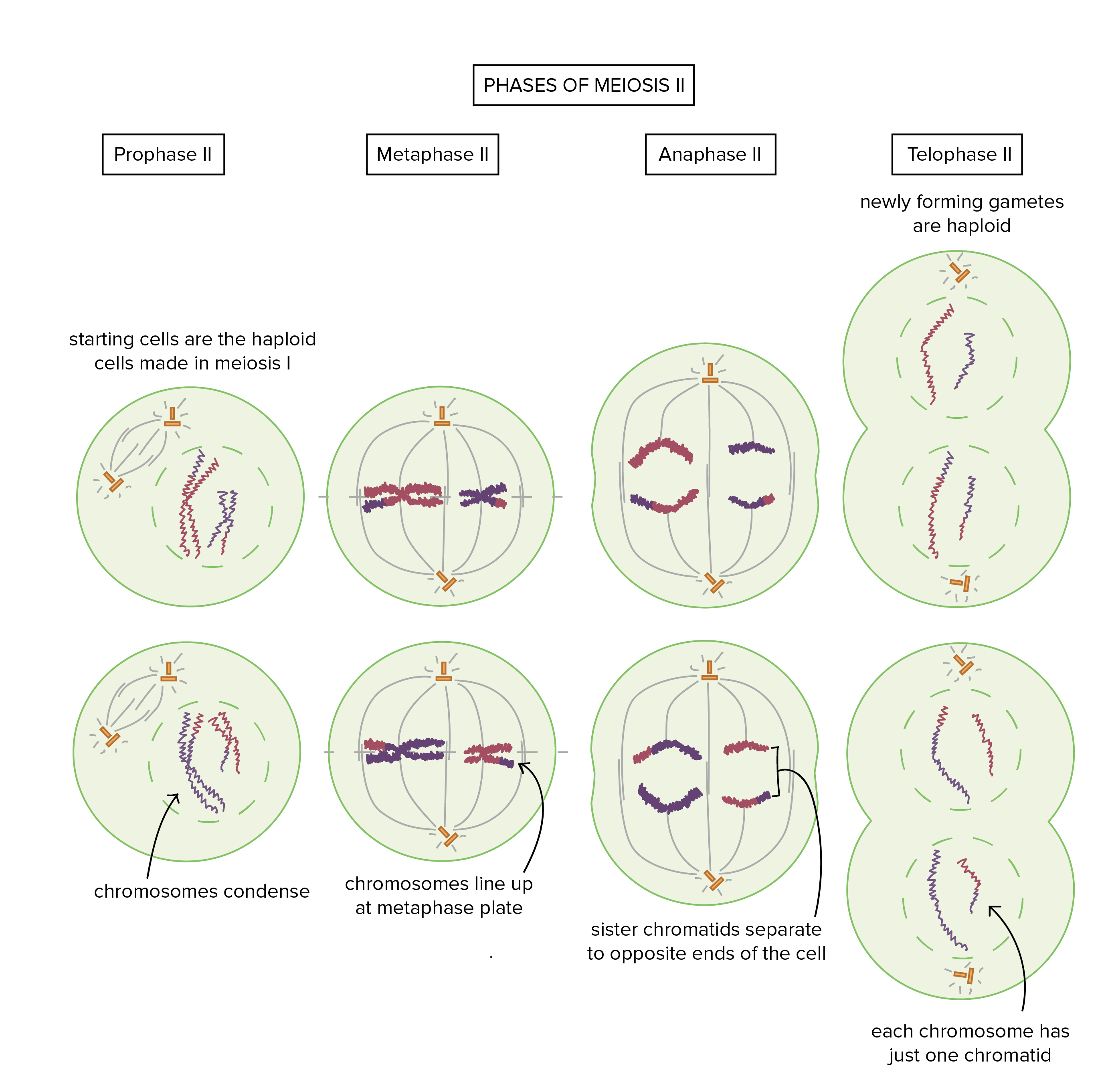
Trait
feature of an individual passed down from parents.

Phenotype
visual presence of a trait
Genotype
Genetic composition of an organism -> eye colour = AA, Aa or aa
Allele
genes that code for different options for a given trait. (2 alleles per trait, 1 from each parent)
Dominant Allele: An allele that can express itself as a trait through a single heterozygous copy or 2 homozygous copies (AA, Aa)
Recessive Allele: Must be present as 2 homozygous copies in order to be expressed as a trait (aa)
Punnet Squares
Predicts genetic outcome of sexual reproduction. Theorises how alleles may be passed from parent to offspring. calculates probability of phenotypes based on predicted genotypes.
Each box is worth 25%.
What are the probabilities of offspring genotypes?
What are the probabilities of offspring phenotypes?
What are the ratios of different genotypes and phenotypes?

Pedigrees
charts displaying the phenotypical characteristics of organisms across generations.

Autosomal Inheritance
when traits are passed down to an offspring on the autosomes, all chromosomes except for X and Y.
Autosomal DOMINANT inheritance
Trait is determined by the expression of the dominant allele. Phenotype will always be expressed over other inherited allele. (AA, Aa Dominantly expressed.) Appears in every generation and affects males/females equally. Muscular Dystrophy and Huntington's disease.

Autosomal RECESSIVE inheritance
Two recessive alleles required to be inherited and phenotypically expressed. Individuals may be carriers of non-exhibiting recessive traits and tend to skip generations. Sickle cell anaemia and Cystic fibrosis.

Sex-linked Inheritance
Traits are passed down to offspring on the sex chromosomes X and Y.
X-linked Dominant
dominant allele is on the X chromosome, individuals with one copy of the allele will express the trait. Affected males transmit the trait to all their daughters and none to their sons. Generations cannot be skipped.
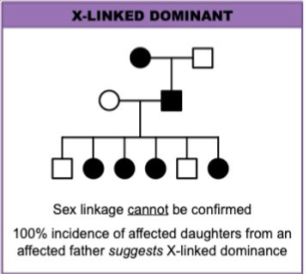
X-linked Recessive
Recessive allele on the X chromosome is expressed only when a person has two copies (female) or one copy (male). Affected males transmit the trait to all their daughters, who become carriers, but not to their sons. Affected females will always infect their male offspring with the trait. Red-green colour blindness.
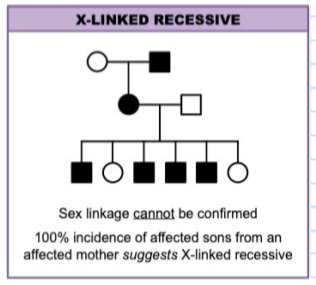
Y-linked
Male offspring inherit their father's Y-chromosome, so any alleles carried on this chromosomes will be passed from father to son. Females are never affected because they never inherit a Y chromosome. Trait is observed in every generation from father to sons

Co-dominance
Both alleles in a gene pair are fully expressed through a third possible phenotype, resulting in a hybrid.

Incomplete dominance
Creates third phenotype → blend of parent alleles
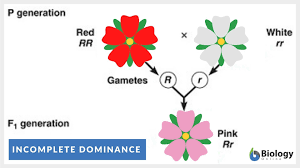
Multiple Alleles
Inheritance heirarchy where three or more alleles exist for a single trait. Example - Fur colour. C (black), Cch (chinchilla), ch (Himalayan), c (albino)
Pattern of dominance for different alleles
C is dominant to all other alleles
Cch is dominant to ch and c but recessive to C
ch is dominant to c but recessive to C and Cch
c is recessive to all other alleles.
DNA sequencing
finds single nucleotide information in entire human genome thru technology
DNA profiling
DNA fingerprinting, determines individuals' unique DNA characteristics, identification of persons. Forensics and paternity testing. STRs or short tandem repeats, are sections of non-coding DNA that are individually unique and repeated many times in electrophoresis.
Isolate the DNA to be profiled
PCR is used to increase/amplify the amount of DNA of the sequence
Gel electrophoresis is used to separate the segments according to length
PCR
Laboratory technique used to make many copies of a particular region of DNA. The goal of PCR is to make enough of the target DNA region in order for it to be analyzed or utilized in some way.

Taq polymerase, primers, template DNA and nucleotides - PCR
Denaturation: Heat reaction strongly to separate or denature DNA strands, breaking strand bonds to produce single strands. DNA Polymerase begins to read singular strands and carries out DNA replication.
Annealing: Cool reaction so primers can bind to their complementary sequences on single stranded template DNA.
Extension: Raise and lower reaction temperatures repeatedly so Taq can extend primers, synthesizing new strands of DNA, with new DNA made in round one serving as a template for the next round of DNA synthesis in the form of a chain reaction and exponential growth.
Results visualised in gel E
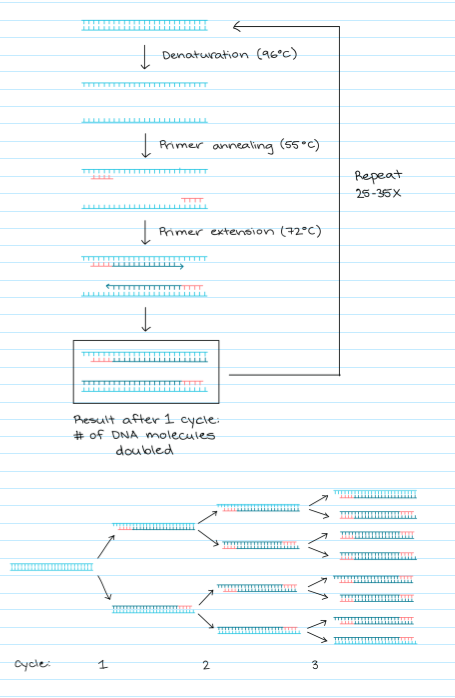
Gel Electrophoresis
technique used to separate DNA fragments based on their size and charge. Determines how many different DNA fragments are present in a sample and how large they are relative to one another.
Step 1
Gel E made of agarose, held by hydrogen bonds → pores
pocket indentations or wells where DNA samples are placed
Box body where gel is placed is filled with salt buffer solution that can conduct current
end of the gel with wells is positioned towards negative elctrode
end without wells (where DNA will migrate) is positioned towards positive electrode
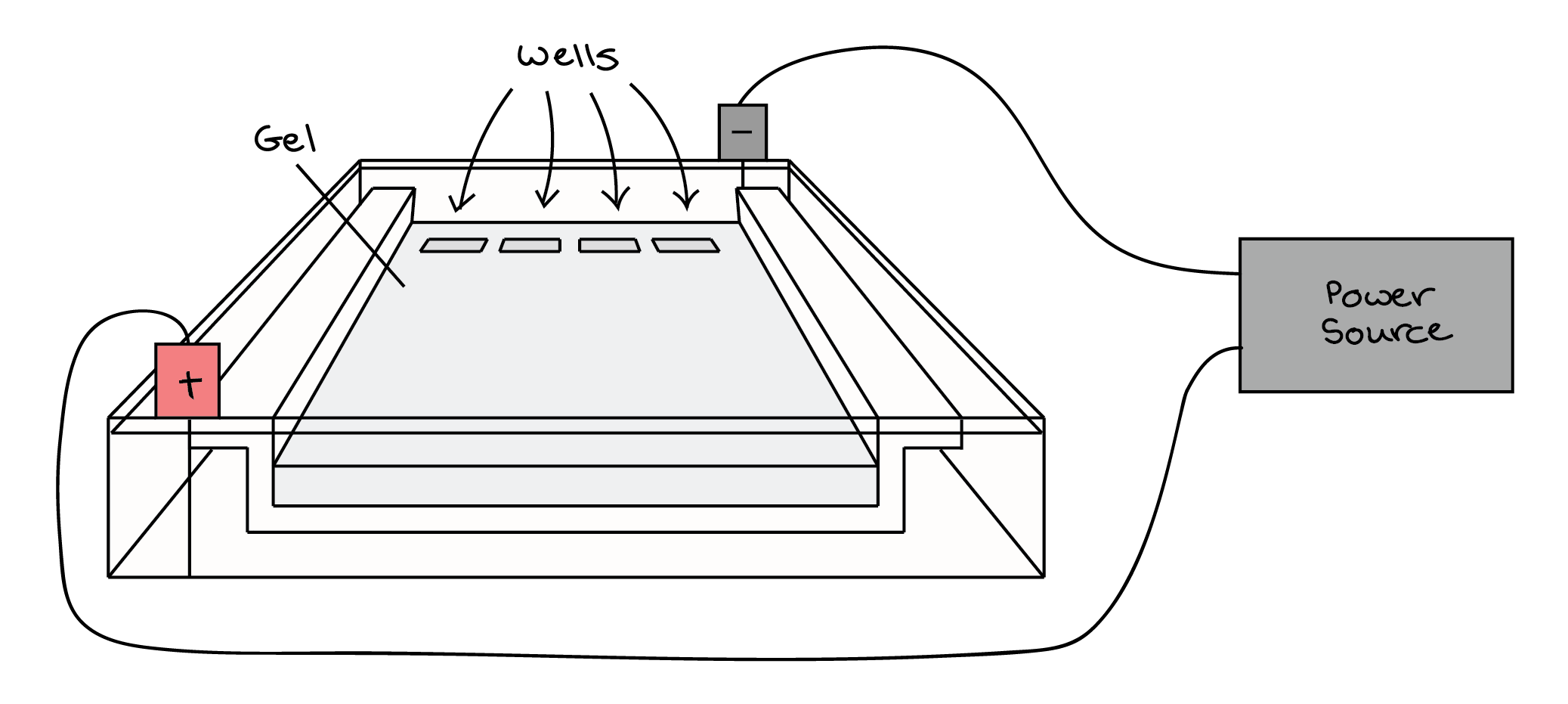
Step 2
DNA samples transferred into wells. One well reserved for DNA ladder
Power to gel box is turned on, current begins to flow through gel
DNA molecules have negative charge due to phosphate groups in backbone → starts moving to positive pole in gel matrix

Step 3
As the gel runs, shorter pieces of DNA will travel through the pores faster than longer ones. The shortest pieces of DNA will be close to the positive end of the gel, while the longest pieces of DNA will remain near the wells.
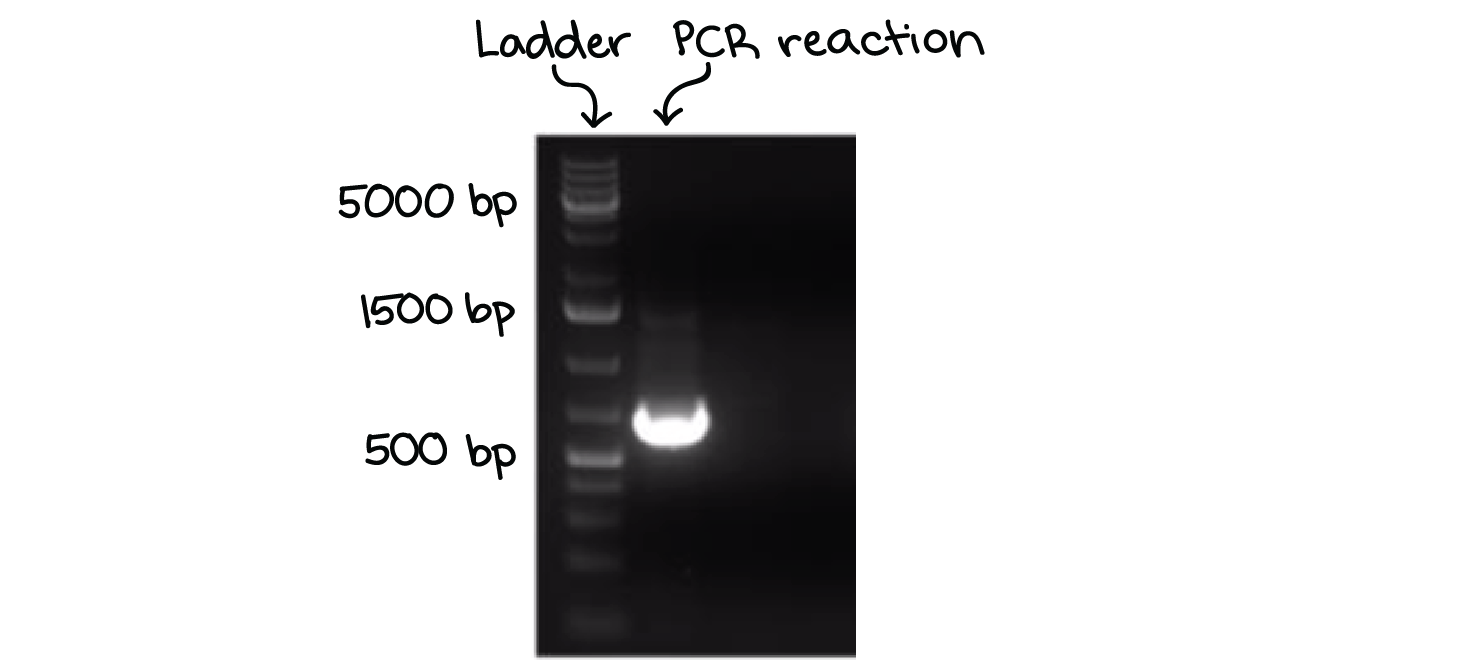
Step 4
After fragments separated, gel stained DNA can be examined under UV light
DNA fragments will glow, allowing us to see DNA present at different locations along gel length
Well-defines ‘line’ of DNA is called a band
Example: By comparing the banding patterns of DNA from a crime scene with those of potential suspects, forensic scientists can determine the likelihood of a match.
